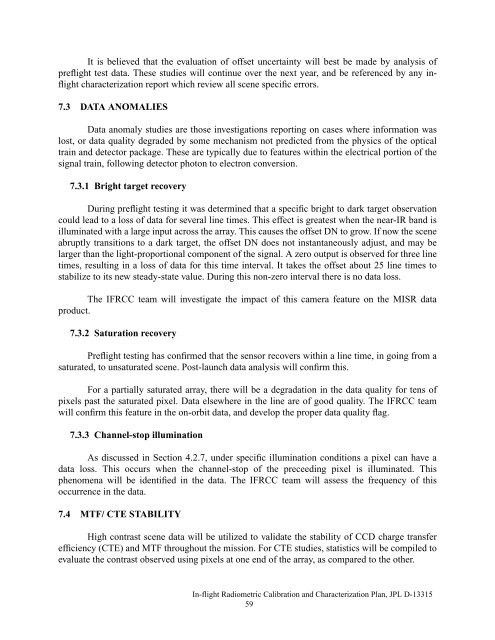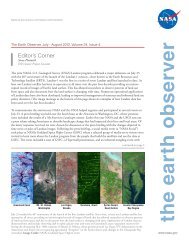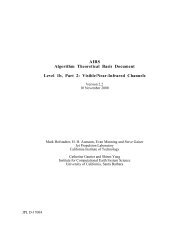MISR: In-Flight Radiometric Calibration and Characterization Plan
MISR: In-Flight Radiometric Calibration and Characterization Plan
MISR: In-Flight Radiometric Calibration and Characterization Plan
Create successful ePaper yourself
Turn your PDF publications into a flip-book with our unique Google optimized e-Paper software.
It is believed that the evaluation of offset uncertainty will best be made by analysis ofpreflight test data. These studies will continue over the next year, <strong>and</strong> be referenced by any inflightcharacterization report which review all scene specific errors.7.3 DATA ANOMALIESData anomaly studies are those investigations reporting on cases where information waslost, or data quality degraded by some mechanism not predicted from the physics of the opticaltrain <strong>and</strong> detector package. These are typically due to features within the electrical portion of thesignal train, following detector photon to electron conversion.7.3.1 Bright target recoveryDuring preflight testing it was determined that a specific bright to dark target observationcould lead to a loss of data for several line times. This effect is greatest when the near-IR b<strong>and</strong> isilluminated with a large input across the array. This causes the offset DN to grow. If now the sceneabruptly transitions to a dark target, the offset DN does not instantaneously adjust, <strong>and</strong> may belarger than the light-proportional component of the signal. A zero output is observed for three linetimes, resulting in a loss of data for this time interval. It takes the offset about 25 line times tostabilize to its new steady-state value. During this non-zero interval there is no data loss.The IFRCC team will investigate the impact of this camera feature on the <strong>MISR</strong> dataproduct.7.3.2 Saturation recoveryPreflight testing has confirmed that the sensor recovers within a line time, in going from asaturated, to unsaturated scene. Post-launch data analysis will confirm this.For a partially saturated array, there will be a degradation in the data quality for tens ofpixels past the saturated pixel. Data elsewhere in the line are of good quality. The IFRCC teamwill confirm this feature in the on-orbit data, <strong>and</strong> develop the proper data quality flag.7.3.3 Channel-stop illuminationAs discussed in Section 4.2.7, under specific illumination conditions a pixel can have adata loss. This occurs when the channel-stop of the preceeding pixel is illuminated. Thisphenomena will be identified in the data. The IFRCC team will assess the frequency of thisoccurrence in the data.7.4 MTF/ CTE STABILITYHigh contrast scene data will be utilized to validate the stability of CCD charge transferefficiency (CTE) <strong>and</strong> MTF throughout the mission. For CTE studies, statistics will be compiled toevaluate the contrast observed using pixels at one end of the array, as compared to the other.<strong>In</strong>-flight <strong>Radiometric</strong> <strong>Calibration</strong> <strong>and</strong> <strong>Characterization</strong> <strong>Plan</strong>, JPL D-1331559







